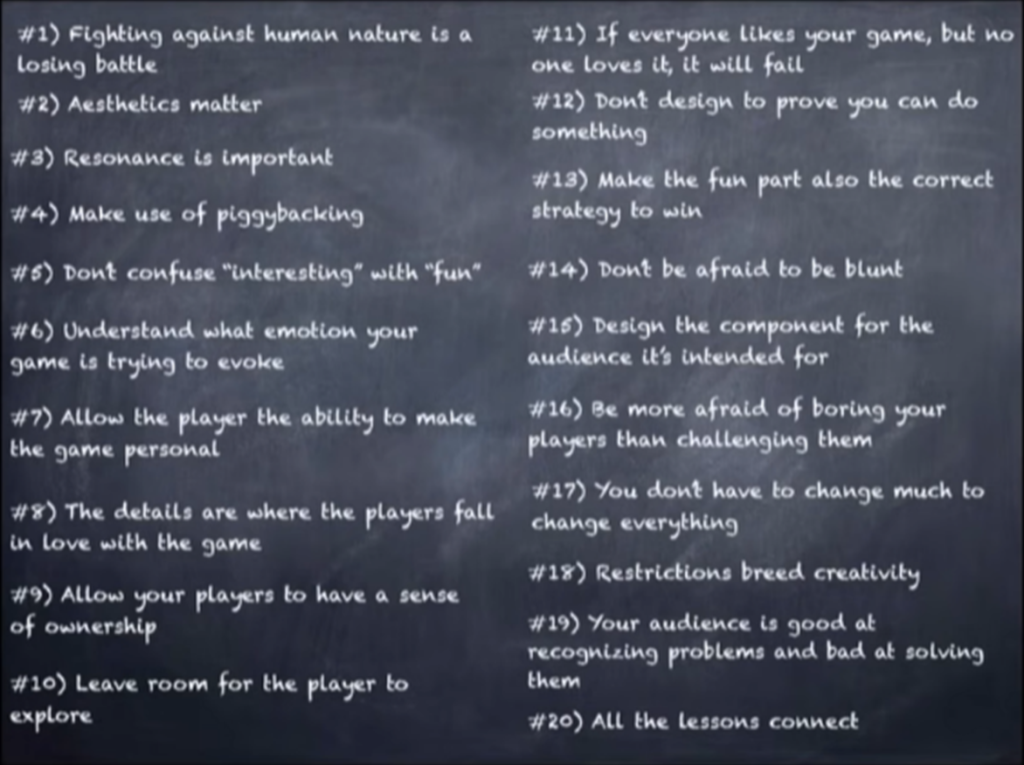I recently enjoyed a GDC talk by Mark Rosewater, the head designer of Magic the Gathering, where he shared his shared some of his thoughts on game design. He has worked for most of his life at Wizards of the Coast, spending the last 20 years designing Magic The Gathering. Not many people design the same game for 20 years, but the changes and the resulting lessons meant that he has learned a lot. He shared some tips when it comes to effectively designing a game, which I will now discuss. These apply mainly to board games and collectible card games but can be applied to video games as well.

Lesson 1: Fighting against human nature is a losing battle
Know your audience. Our audience is human. It comes with a complex operating system. While quirky, it can be understood.
- But as game designers, know humans can be stubborn.
- Don’t change your players to match your game, change your game to match your players.
- You are going to lose the fight.
- There are things that can change human behavior, but don’t assume your game is one of those things.
Lesson 2: Aesthetics Matter
Understanding human behavior is important. But You must understand human perception in relation to aesthetics.
- Aesthetics refers to the philosophy of art and the science of beauty. It is a study of how humans perceive the things around them.
What is aesthetically pleasing?
- While there are variants, there are rules that make some things more appealing than others. Players have an expectation of feeling. Not just visual aesthetics. It has to feel right. Things like Balance, Symmetry, Pattern completion. If you get this wrong, it distracts the players and makes them feel ill at ease. It distracts the user’s attention to what the game isn’t, rather than what the game is. In the same way you don’t fight human nature, you don’t fight human perception.
- Humans like to perceive things in a certain way, and if you fight that, it will just draw attention to it.
- How people perceive things has an impact on how the game is perceived.
Lesson 3: Resonance is important
Humans come preloaded. You don’t start from scratch, the audience already has preexisting emotional responses that he game designer can build upon. Magic didn’t create zombies. Players came to the game with a preloaded knowledge of zombies from pop culture. The game just builds on this.
- Your audience has a deep deposit of emotional resonance to topics. Use it. Build upon it.
- They come with emotional responses built in. You should take advantage of that.
Lesson 4: Make use of piggybacking.
Resonance is a tool for more than just emotional responses.
- It can provide context to the user and allow them to understand.
- If it matches expectation and heuristics, it is easier to understand.
- Plants vs Zombies chose plants because they can’t move – perfect for a tower defense game. He also needed something that keeps coming in waves. Thus, Zombies and plants were carefully selected to reinforce the game mechanics.
- You don’t have to teach players things they already know.
- Resonance will emotionally attach your audience, but it’s also a tool for teaching.
Lesson 5: Don’t confuse interesting with fun.
Two types of stimulation
- Intellectual stimulation -interesting
- Emotional stimulation – fun
We think of ourselves as intellectual creatures, but make our decisions based more on emotion. When you speak to a player on an emotional level, you engage on a more enjoyable level. You want to get an emotional response out of your audience. Fun is the priority.
Lesson 6: Understand what emotion your game is trying to evoke.
What is your audience trying to experience? To know what to put into a game, you must know what you are looking to get out of the game.
- If it doesn’t contribute to the overall experience, cut it.
- No line is worth a scene – No scene is worth a movie. If it’s not serving the larger movie, it needs to be cut. If the line doesn’t serve the film scene, it needs to be cut. The same applies to game design. Everything in the game has to contribute to the emotional output of your game.
- What emotion are you trying to evoke? Every mechanic should push this.
Lesson 7: Allow the player to make the game something personal.
You are most likely to buy the brand you are most familiar with. We associate knowledge with quality. If you know it, it must be better.
- Familiarity = Preference = Perception of Quality.
- It’s important for players to feel the game is about them.
- Provide them different choices.
- Give the players the ability to choose or NOT choose things.
- This makes players feel like the events are truly their own.
- In magic the gathering, you can choose you faction, color, sleeves, cards etc.
- The players will think more highly of things they have a personal connection to – so give them things that give them a particular personal connection.
Lesson 8: The details are where the player falls in love with your game.
When playing a game, they are looking for something to bond with – even over a single image. This means that details matter, because the individual will bond with the game through the details.
- Details are everything.
- The details are where the player falls in love with your game.
- People are individuals. They want to come to a game and find something that they claim to be their own.
- Not everyone will care about every detail, but someone will care about some detail.
Lesson 9: Allow your players to have a sense of ownership
- Give a sense of customization, to build things that are uniquely your own.
- When a player creates a deck, it is their deck, an extension of themselves.
- When they win a game, they feel like they have won the game.
- The key is customization, means that no one else can do what they did.
Lesson 10: Leave room for your players to explore.
- People are more invested in things that they initiated.
- If they find it, they are more invested.
- Don’t just give it to them. Get them to ask and inquire, get invested and discover the story
Lesson 11: If everyone likes your game but no one loves it, it will fail.
Like a relationship, it doesn’t matter if a person ticks all the box, there needs to be love. Something has to draw them in and then keep them.
- Strong responses are important, even sometimes negative ones can work (think of the stress when playing a close game).
- Thus, focus more on creating positive responses instead dedicating yourself to totally eradicating all the negative responses.
- Don’t worry about things that players hate, worry more about getting a player to love something.
Lesson 12: Don’t design to prove you can do something.
It takes ego to will something into existence. Designers have large egos. But don’t let ego drive motivations.
- Your game needs to serve a target audience.
- Is this decision for me or for my audience?
- Am I following my own desires for a game or not looking?
- It’s not about yourself, it’s about making the best game possible.
Lesson 13: Make the fun part also the correct strategy to win
If you do what the game tells you to do it will be a enjoyable experience. So they will follow the rules in expectation of this promise. Humans will follow rules of the game, even if it isn’t fun.
- Design rules that embrace human behavior, no restrict it.
- Restricting it is to restrict fun.
- If players don’t have fun, they will blame the game. They did what you asked, but you did not deliver on fun.
- Fun has to be the core component of the game strategy.
- If players find unfun parts of your game, you put it there.
Lesson 14: Don’t be afraid to be blunt.
Subtlety is great, but sometimes it does not work. People can miss the obvious. Keywords to mechanics are important, you have to embrace bluntness to get them to understand.
- We as artists are taught subtlety, but that doesn’t mean that you can’t use bluntness when it will get across what you need to get across.
Lesson 15: Design the components for your audience.
Design any one component, know what it is intended for.
- Design the component for the audience it is intended for.
- You have lots of different players, cater to them, make something for everybody.
- The person who hates something can always go to something they love.
Lesson 16: Be more afraid of boring your players than challenging them
People fear challenging the players more than boring them. But this is wrong.
- Players respect the attempt at awesomeness. But when you bore the players, there is no such forgiveness. They resent the game and stop playing.
- The greatest risk is not taking risk.
- Risk aversion, respect your players, it’s better to fail at something exciting than something boring.
Lesson 17: You don’t have to change much to change everything.
Like cooking, you can add too much complexity, add too much.
- Rather ask how little do I need to add?
- One tiny change can have a huge impact.
Lesson 18: Restrictions breed creativity.
Myth: more options available, more creative a person can be. But, when asked to solve a problem, the brain goes back and asks, have I solved this? If yes, it pulls that information back.
- But the problem with creative thought, is that you don’t want to get to the same places. But if you start at a different place, you force yourself to think in new ways, new ideas, new solutions.
- These restrictions are a valuable tool and breed creativity. Having restrictions narrows in your scope.
Lesson 19: Your audience is good at recognizing problems but not solving them.
The doctor asks how you are feeling, but not how to make you better. Players can tell when something is wrong, but they cannot solve them. They don’t know the tools, limitations, design pillars etc.
- Use your audience as a resource to gauge what is wrong but take their solutions with a grain of salt.
- They are experts in identifying problems, but their solutions can be uninformed.
Lesson 20: All the lessons connect.
All these lessons exist within an ecosystem. They are holistic to game design and flow interconnected to each other.
